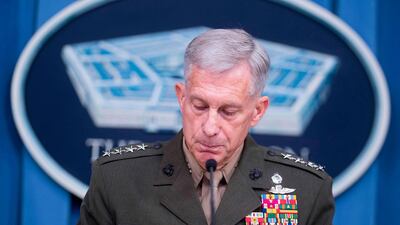Multiple failures are to blame for the Niger ambush that killed four US service members last October, the Pentagon said on Thursday, citing insufficient training and preparation as well as the team’s deliberate decision to go after a high-level ISIS group insurgent without proper command approval.
A report summary released Thursday includes recommendations to improve mission planning and approval procedures, re-evaluate equipment and weapons requirements, and review training that US commandos conduct with partner forces.
Defense secretary Jim Mattis directed General Thomas Waldhauser, head of US Africa Command, to take immediate steps to address shortfalls, and has given senior leaders four months to complete a review and lay out a plan for additional changes.
At a Pentagon news conference, General Waldhauser said he takes responsibility for what happened.
“I take ownership of all the events connected to the ambush of October 4,” he told reporters. “Again, the responsibility is mine.”
The general said changes have already been made in the way military activities are carried out in Niger and elsewhere in Africa.
“We are now far more prudent on our missions,” he said.
The summary lays out a confusing chain of events that unfolded between October 3-4, ending in a lengthy, brutal firefight as 46 US and Nigerien forces battled for their lives against more than 100 enemy fighters. Amid the chaos, it identifies repeated acts of bravery as the outnumbered and outgunned soldiers risked their lives to protect and rescue each other during the more than hour-long assault.
“This investigation identifies individual, organisational, and institutional failures and deficiencies that contributed to the tragic events of October 4, 2017,” the summary said. But it concludes that “although the report details the compounding impact of tactical and operational decisions, no single failure or deficiency was the sole reason.”
Military officials found that the US forces didn’t have time to train together before they deployed and did not do pre-mission battle drills with their Nigerien partners. And the report found there was a lack of attention to detail and lax communication about missions that led to a “general lack of situational awareness and command oversight at every echelon.”
General Waldhauser said the report, which has not yet been made public in full, singles out three individuals whose actions could be faulted. Whether they are disciplined is a matter to be decided by US Special Operations Command, he said.
Robert S Karen, the assistant secretary of defense for international security affairs, who spoke alongside the general, said there are about 800 US troops in Niger, and that none are supposed to be engaged in direct combat.
According to the report, the Army Special Forces team left Camp Ouallam on October 3 to go after Doundou Chefou, an IS leader who was suspected of involvement in the kidnapping of an American aid worker. But the team leader and his immediate supervisor submitted a different mission to their higher command, saying they were simply going out to meet tribal leaders. That less-risky mission was approved, but when the Ouallam team got to the location the insurgent wasn’t there.
Senior commanders, unaware of the team’s earlier actions, then ordered the troops to serve as back-up for a second team’s raid, also targeting Chefou. That mission was aborted when weather grounded the second team. The Ouallam team members were then ordered to another location to collect intelligence also linked to Chefou, which they did without problems. On their way back to their home base they stopped at the village of Tongo Tongo to get water.
Soon after leaving Tongo Tongo, about 200 km north of Niamey, Niger’s capital, they were ambushed by Islamic State-linked militants carrying small arms and rocket-propelled grenade launchers.
The report concludes that although the enemy can move freely around the village area, “there is not enough evidence to conclude that the villagers of Tongo Tongo willingly (without duress) aid and support them. Additionally, there is insufficient evidence to determine if villagers aided the enemy or participated in the attack.”
Four Nigerien troops were also killed, and two American soldiers and eight Nigerien forces were wounded.
The report says that the four soldiers killed in the attack “gave their last full measure of devotion to our country and died with honour while actively engaging the enemy.” It says that none were captured alive by the enemy, and all died immediately or quickly from their wounds. Sergeant La David Johnson and two Nigerien soldiers got separated from the others during the battle and were gunned down, but his body wasn’t found until two days later.
The investigation was led by US Africa Command’s chief of staff, Major General Roger Cloutier Jr, whose team conducted dozens of interviews across the US, Europe and Africa.
Families of the fallen have expressed frustration with the incident and the briefings they got.
“The whole thing was a screwed-up mess,” said Arnold Wright, father of Staff Sergeant Dustin Wright of Lyons, Georgia, who was killed in the attack. Mr Wright said he’s concerned the Army may be pinning blame on lower-ranking soldiers and not accepting responsibility high enough up the chain of command.
The briefing, he said, gave the impression “that the captain, the team leader, that he mischaracterised the mission” as one to reach out to local leaders rather than a mission to target the insurgent.

